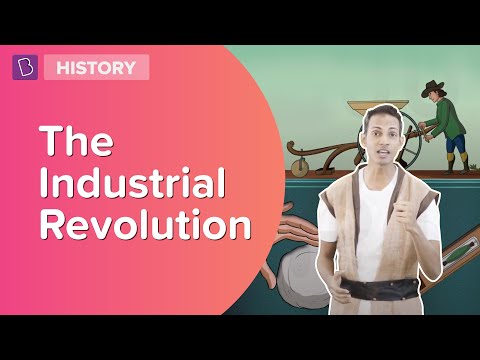According to the CBSE Syllabus 2023-24, this chapter has been renumbered as Chapter 4.
Have you ever given thought to the fact that the notebook you use for writing has come to you after a long process of manufacturing? It started out its life as part of a tree, which was then cut down and transported to the pulp mill, where the wood of the tree was processed and converted into wood pulp. The wood pulp was mixed with chemicals and finally changed into paper by the machines. Secondary activities or manufacturing change raw materials into products of more value to people. For example, see how pulp was changed into paper and paper into a notebook. These represent the two stages of the manufacturing process. Meanwhile, Industry refers to economic activity that is concerned with the production of goods, extraction of minerals or the provision of services. Thus, we have the iron and steel industry (production of goods), the coal mining industry (extraction of coal) and the tourism industry (service provider). Students can revise the Chapter thoroughly with the help of CBSE Notes Class 8 Geography Chapter 5. These notes have been created with the idea of making the students prepare for the exams thoroughly.
Find below in this article, the PDF link from where the students can download the CBSE Class 8 Social Science Notes from Geography Chapter 5
CBSE Notes Class 8 Geography Chapter 5 Industries
Classification of Industries
Industries are classified on the basis of raw materials, size and ownership.
Industries Classified on the basis of Raw Materials: agro-based, mineral-based, marine-based and forest-based. Agro-based industries use plant and animal-based products as their raw materials-examples are food processing, vegetable oil, cotton textile, dairy products and leather industries. Mineral based industries-primary industries use mineral ores as their raw materials- products of these industries feed other industries-one product is Iron made from iron ore- used as raw material for the manufacture of a number of other products, such as heavy machinery, building materials and railway coaches. Marine-based industries- use products from the sea and oceans as raw materials- Given examples are Industries processing seafood or manufacturing fish oil. Forest-based industries-utilise forest produce as raw material- industries associated with forests are pulp and paper, pharmaceuticals, furniture and buildings.
Industries Classified on the basis of Size: Size refers to the amount of capital invested, the number of people employed and the volume of production- classified into the small scale and large scale industries-Cottage or household industries where products are manufactured by hand by the artisans-Examples of cottage industry are basket weaving, pottery and other handicrafts. Small-scale industries– use a lesser amount of capital and technology. Large Scale Industries-produce large volumes of products-investment of capital is higher- technology used is superior- Silk weaving and food processing industries are small-scale industries while the production of automobiles and heavy machinery are large-scale industries.
Industries are classified on the basis of Ownership: Private sector, state-owned or public sector, joint sector and cooperative sector.
Private Sector Industries-owned and operated by individuals or a group of individuals.
Public Sector Industries– owned and operated by the government, such as Hindustan Aeronautics Limited and Steel Authority of India Limited.
Joint Sector Industries-owned and operated by the state and individuals or a group of individuals-Maruti Udyog Limited is an example.
Cooperative Sector Industries-owned and operated by the producers or suppliers of raw materials, workers or both-Anand Milk Union Limited and Sudha Dairy.
Factors Affecting the Location of Industries
Availability of raw material, land, water, labour, power, capital, transport and market- Industries are usually located at areas where these are easily available-government provides incentives like subsidised power, lower transport cost and other infrastructure so that industries may be located in backward areas-Industrialisation often leads to development and growth of towns and cities.
Industrial System
The Industrial System consists of inputs, processes and outputs:
- inputs are the raw materials, labour and costs of land, transport, power and other infrastructure
- processes include a wide range of activities that convert the raw material into finished products
- outputs are the end product and the income earned from it
Industrial Regions
Industrial regions emerge when a number of industries locate close to each other and share the benefits of their closeness- eastern North America, western and central Europe, eastern Europe and eastern Asia (Major Industrial Regions of the World)- they are located in the temperate areas, near seaports and especially near coalfields.
- Industrial Regions in India-Mumbai Pune cluster, Bangalore-Tamil Nadu region, Hugli region, Ahmedabad-Baroda region, Chottanagpur industrial belt, Vishakhapatnam-Guntur belt, Gurgaon-Delhi-Meerut region and the Kollam-Thiruvananthapuram industrial cluster.
To know about impact and Causes of Urbanisation, watch the below video

Distribution of Major Industries
World’s major industries-iron and the steel industry, the textile industry and the information technology industry. Countries in which the iron and steel industry is located are Germany, USA, China, Japan and Russia. The textile industry is focused in India, Hong Kong, South Korea, Japan and Taiwan. Major hubs of the Information technology industry are the Silicon Valley of Central California and the Bangalore region of India.
Iron and Steel Industry
It is a feeder industry whose products are used as raw materials for other industries- inputs for the industry are raw materials (iron ore, coal and limestone, along with labour, capital, site and other infrastructure)-the process of converting iron ore into steel involves many stages (raw material is put in the blast furnace where it undergoes smelting and is then refined)-output obtained is steel (may be used by other industries as raw material).
Steel– tough, can easily be shaped, cut, or made into wire-Special alloys of steel can be made by adding small amounts of other metals such as aluminium, nickel, and copper.
Important steel-producing centres-Bhilai, Durgapur, Burnpur, Jamshedpur, Rourkela, Bokaro are situated in a region that spreads over four states — West Bengal, Jharkhand, Odisha and Chhattisgarh. Bhadravati and Vijay Nagar in Karnataka, Visakhapatnam in Andhra Pradesh, Salem in Tamil Nadu.
Jamshedpur: Before 1947, only one iron and steel plant in the country – Tata Iron and Steel Company Limited (TISCO)-was privately owned- After Independence, the government took the initiative and set up several iron and steel plants. TISCO started in 1907 at Sakchi, near the confluence of the rivers Subarnarekha and Kharkai in Jharkhand. Later Sakchi was renamed as Jamshedpur.
Benefits of the place
- Only 32 km away from Kalimati station on the Bengal-Nagpur railway line
- Close to the iron ore, coal and manganese deposits as well as to Kolkata, which provided a large market
- TISCO gets coal from Jharia coalfields, and iron ore, limestone, dolomite and manganese from Odisha and Chhattisgarh
- The Kharkai and Subarnarekha rivers ensured sufficient water supply
- Government initiatives provided adequate capital for its later development
Pittsburgh: Important steel city in the United States of America enjoys locational advantages. Raw material such as coal is available locally, while iron ore comes from the iron mines in Minnesota, about 1500 km from Pittsburgh-one of the world’s best routes for shipping ore cheaply; the famous Great Lakes waterway lies between these mines and Pittsburgh-Trains carry the ore from the Great Lakes to the Pittsburgh area-Ohio, the Monogahela and Allegheny rivers provide adequate water supply-Finished steel is transported to the market by both land and water routes-Pittsburgh area has many factories that use steel as their raw material to manufacture railroad equipment, heavy machinery and rails.
Cotton Textile Industry
Weaving cloth from yarn is an ancient art- Cotton, wool, silk, jute, flax are used for making cloth-textile industry is divided on the basis of raw materials used.
Fibres, the raw material, can be natural or man-made.
Natural fibres: obtained from wool, silk, cotton, linen and jute
Man-made fibres: nylon, polyester, acrylic and rayon- one of the oldest industries in the world- Till the industrial revolution in the 18th century, cotton cloth was made using hand-spinning techniques (wheels) and looms-In 18th-century power looms facilitated the development of cotton textile industry- first in Britain and later in other parts of the world-important producers of cotton textiles are India, China, Japan and the USA.
For more information on the Industrial Revolution, watch the below video

The Muslins of Dhaka, Chintzes of Masulipatnam, Calicos of Calicut and gold-wrought cotton of Burhanpur, Surat and Vadodara were known worldwide for their quality and design- manufacturing these was time-consuming and expensive- the traditional cotton textile industry was unable to face the competition from the new textile mills of the West that produced cheap and good quality fabrics through mechanized industrial units- first successful mechanized textile mill was established in Mumbai in 1854-warm, moist climate, a port for importing machinery, availability of raw material and skilled labour led to the rapid expansion of the industry in the region-industry flourished in the states of Maharashtra and Gujarat initially because of favourable humid climate-But today, humidity can be created artificially-Other important centres are Coimbatore, Kanpur, Chennai, Ahmedabad, Mumbai, Kolkata, Ludhiana, Puducherry and Panipat.
Ahmedabad: located in Gujarat on the banks of the Sabarmati river- first mill established in 1859-second largest textile city of India, following Mumbai- referred to as “Manchester of India”-situated very close to cotton growing area ensures easy availability of raw material-ideal climate for spinning and weaving-flat terrain and easy availability of land makes it suitable establishment for mills- provide both skilled and semi-skilled labour- Well developed road and railway network permits easy transportation of textiles to different parts of the country also providing easy access to the market. Mumbai port nearby facilitates import of machinery and export of cotton textiles-Issues in Ahmedabad textile mills-Several textile mills closed down due to the emergence of new textile centres in the country as well as non-upgradation of machines and technology in the mills of Ahmedabad.
Osaka: an important textile centre of Japan, also known as the ‘Manchester of Japan.’- geographical factors facilitating the growth of the textile industry in Osaka are listed below:
- The extensive plain around Osaka ensured that land was easily available for the growth of cotton mills
- The warm humid climate is well suited to spinning and weaving
- River Yodo provides sufficient water for the mills-Labour is easily available
- The location of port facilitates the import of raw cotton and for exporting of textiles
The textile industry in Osaka depends completely upon imported raw materials. Cotton is imported from Egypt, India, China and the USA. The finished product is mostly exported and has a good market due to good quality and low price. Despite it being an important textile city in the country, of late, the cotton textile industry of Osaka has been replaced by other industries, such as iron and steel, machinery, shipbuilding, automobiles, electrical equipment and cement.
For more information on Industries, watch the below video

Frequently Asked Questions on CBSE Class 8 Geography Notes Chapter 5 Industries
What is the impact of urbanisation?
1. Creation of employment opportunities 2. Technological and infrastructural advancement 3. Improved standard of living 4. Improved transportation and communication
What is an Industrial Revolution?
An industrial revolution is the process of change from an agrarian and handicraft economy to one dominated by industry and machine manufacturing.
What is Jamshedpur famous for?
Jamshedpur is the largest city in the state of Jharkhand. It was named after the renowned industrialist Jamshetji Tata and is home to such industrial giants as Tata Steel and Tata Motors.
Comments